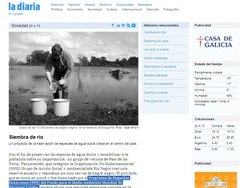 A project to conserve freshwater species grows in the center of the country. In order to preserve freshwater species and educate the public about its importance, a group of residents of Paso de los Toros, Tacuarembó, members of the nongovernmental Organization called "Grupo de Acción Social y Ambientalista Río Negro" in Uruguay created a reserve-aquarium and reproduced 20,000 larvae of black catfish. The project, which began in 2006 and was funded by the Small Grants Programme (SGP) of the Global Environment Facility Nations United now have a second stage that involves the creation of a theme park of freshwater species in the vicinity of the dam called "Rincón del Bonete" which willreproduce two fresh water species that can't be found in the river anymore such us el dorado y boga.
A project to conserve freshwater species grows in the center of the country. In order to preserve freshwater species and educate the public about its importance, a group of residents of Paso de los Toros, Tacuarembó, members of the nongovernmental Organization called "Grupo de Acción Social y Ambientalista Río Negro" in Uruguay created a reserve-aquarium and reproduced 20,000 larvae of black catfish. The project, which began in 2006 and was funded by the Small Grants Programme (SGP) of the Global Environment Facility Nations United now have a second stage that involves the creation of a theme park of freshwater species in the vicinity of the dam called "Rincón del Bonete" which willreproduce two fresh water species that can't be found in the river anymore such us el dorado y boga.
A project to conserve freshwater species grows in the center of the country. In order to preserve freshwater species and educate the public about its importance, a group of residents of Paso de los Toros, Tacuarembó, members of the nongovernmental Organization called "Grupo de Acción Social y Ambientalista Río Negro" in Uruguay created a reserve-aquarium and reproduced 20,000 larvae of black catfish. The project, which began in 2006 and was funded by the Small Grants Programme (SGP) of the Global Environment Facility Nations United now have a second stage that involves the creation of a theme park of freshwater species in the vicinity of the dam called "Rincón del Bonete" which will reproduce two fresh water species that can't be found in the river anymore such us el dorado y boga.
The project received $ 17,000 dollars in funding which allowed to create a reservation-aquarium with over 500 copies of 50 different species of fish, molluscs, crustaceans and aquatic plants in the reservoir of the Hydroelectric Dam Baygorria corner, located on the Black River.
The aquarium located in the center of the town, seeks to sensitize the public and fishermen on the importance of freshwater species in that area, who are at risk for various reasons, including the presence of alien species and certain fishing practices.
In addition, the project boosted the artificial reproduction of black catfish in quantities that allow maintaining and increasing the reserve and making periodic returns of this species to river. The initiative was successful and in one intervention 20 000 larvae were obtained, of which half were released last month in the reservoir of the dam Baygorria and the other half was donated to a fish farming project in a rural school in the department of Artigas, ultimately destined for consumption in the dining room of that institution. However, this year a sanitary problem in production prevented the National Aquatic Resources (Dinara), responsible for providing the fingerlings, from providing those animals to the school project.
Esteban Calone, a veterinarian specializing in fish and president of the Black River NGO, told the newspaper La Diaria that the main objective of the project is "to reprodcue all commercial species with productive interest to preserve them. "
"What we're trying to do is to promote and enhance our native species that are not valued. When you go to buy species for a fish tank you choose exotic species, "he said.
The reserve-aquairum, a place to visit, has 40 tanks of 400 liters and a collection with a very wide range of different species. "Most people are amazed at the number and diversity of species that we have they did not know, even people involved in the river as fishermen. " According to Calone, one can preserve what you know but "it is difficult to become aware of the need to care for something that they don't know. We must create awareness so people value the river. "
In addition to an exhibition area where guided tours are offered in order to familiarize the visitor to each animal, the place has a laboratory where the group, led and assisted by Calone, performed reproduction experiments of some species.
*This article is a translation of the article by Inés Acosta published in the newspaper La Diaria in Uruguay. To read the original article please visit: http://ladiaria.com/articulo/2010/4/siembra-de-rio/




